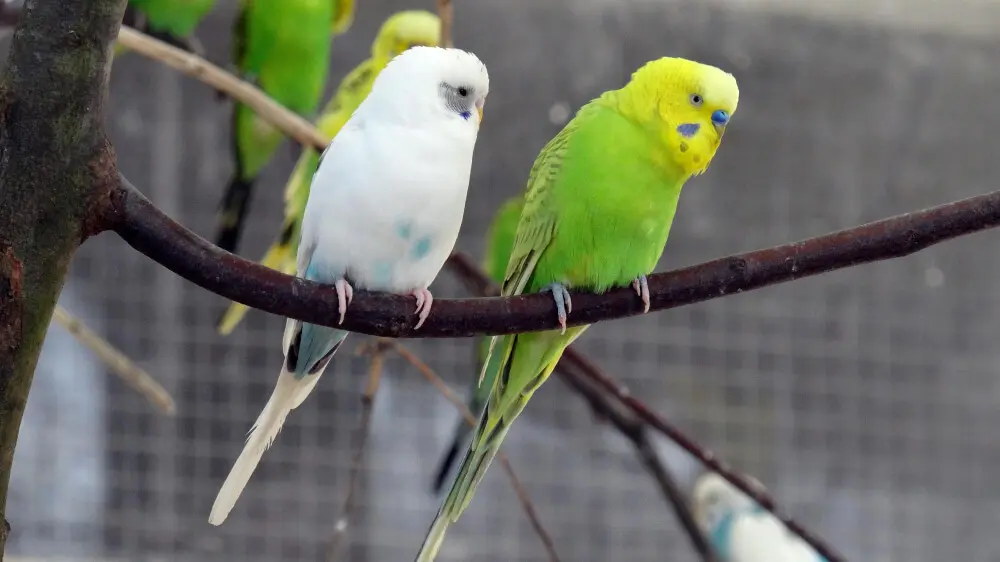Introduction
If you’re a bird enthusiast or just considering getting a pet bird, you’ve likely heard of budgerigars, commonly known as budgies or parakeets. These small, colorful birds are popular pets around the world due to their charming personalities and striking appearances. But did you know there are different types of budgerigars? Understanding the various budgie varieties can help you choose the best one for your home and provide the right care for your feathered friend.

A stunning blue budgerigar sits gracefully on a tree branch, showcasing its vibrant colors in a natural setting.
In this blog post, we’ll explore the different types of budgerigars, from the common wild-type budgerigar to the more specialized English and American budgerigars. We’ll also dive into the fascinating color variations that make these birds so unique. Whether you’re a seasoned bird owner or a newbie looking to learn more, this guide will provide valuable insights into the wonderful world of budgies. So, let’s get started and discover the diverse and delightful types of budgerigars you can welcome into your life.
What are Budgerigars?
Budgerigars, often affectionately called budgies, are small, vibrant parrots native to Australia. These birds are a type of parakeet, known for their playful nature and ability to mimic sounds, making them delightful companions. Budgerigars are one of the most popular pet birds worldwide, thanks to their manageable size and engaging personalities.
A typical budgerigar is about 7 inches long from beak to tail, with a wingspan of around 12 inches. They usually have bright green bodies with yellow heads and black barring on their wings. However, selective breeding has introduced a wide array of color mutations, ranging from blue and white to yellow and grey.
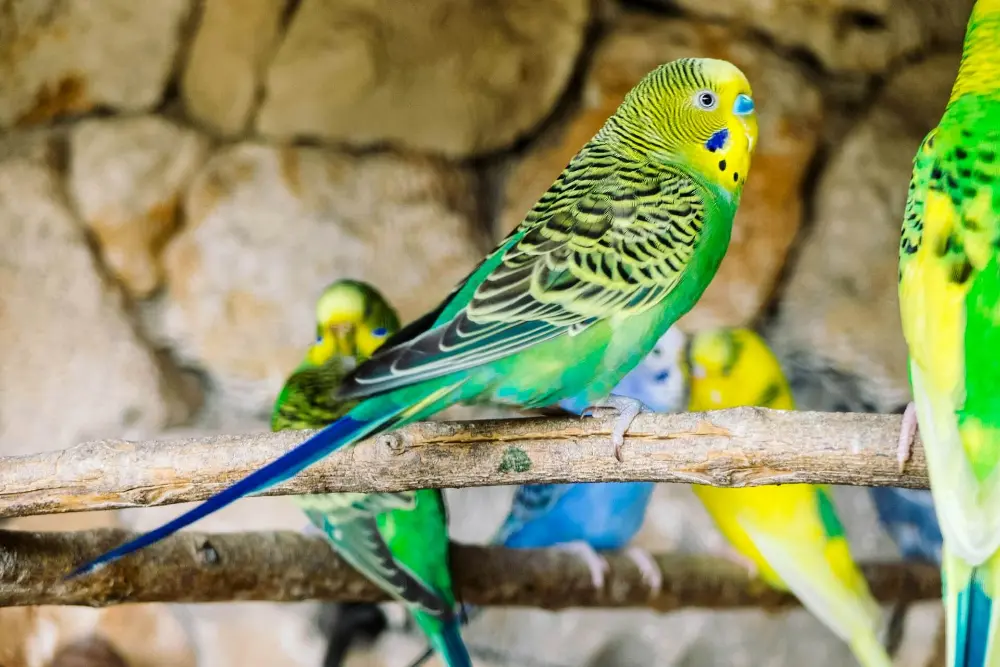
A close-up view of a green budgerigar inside its cage, providing a detailed look at its vibrant feathers and curious expression.
Budgerigars are social creatures that thrive on interaction, whether it’s with their human caregivers or fellow budgies. They are relatively easy to care for, making them ideal pets for both beginners and experienced bird owners. Their diet mainly consists of seeds, fruits, and vegetables, which are essential for maintaining their vibrant plumage and overall health.
In the wild, budgerigars live in large flocks and are constantly on the move, searching for food and water in the arid regions of Australia. This natural behavior translates to a lively and active pet that enjoys plenty of mental and physical stimulation. Providing toys, perches, and regular social interaction is key to keeping your budgie happy and healthy.
Whether you’re captivated by their cheerful chirping or their dazzling array of colors, budgerigars are a joy to have as pets. Understanding what budgerigars are and what makes them unique will help you appreciate these delightful birds even more. Stay tuned as we explore the different types of budgerigars and their specific characteristics.
Origin and History of Budgerigars
Budgerigars, or budgies, have a rich history that traces back to the vast, arid landscapes of Australia. These small parrots have been thriving in the wild for millions of years, long before they became popular pets around the globe.
The natural habitat of budgerigars spans across the Australian outback, where they live in large flocks and migrate in search of food and water. These resilient birds have adapted to the harsh conditions of the Australian desert, developing a diet that includes seeds from native grasses and plants. Their bright green and yellow plumage provides excellent camouflage in the wild, helping them blend in with their surroundings and avoid predators.

A flock of wild budgerigars soars over the Australian landscape, illustrating their natural behavior and vibrant community.
Budgerigars were first documented by Europeans in the late 18th century, but it wasn’t until the mid-19th century that they were brought to Europe as exotic pets. The first recorded importation of budgerigars to England was in 1840, thanks to ornithologist John Gould. Their vibrant colors and playful nature quickly captured the hearts of bird enthusiasts, leading to a surge in popularity.
Selective breeding in captivity has since produced a wide variety of budgerigar types and color mutations, ranging from the common wild-type budgerigar to the larger English budgerigar and the various color variants we see today. These breeding efforts have not only diversified the appearance of budgies but also helped enhance certain traits, making them even more appealing as pets.
In their native Australia, budgerigars remain a symbol of the country’s unique wildlife. They continue to flourish in the wild, often seen in massive flocks that can number in the thousands. Their ability to survive and thrive in such challenging environments is a testament to their resilience and adaptability.
Understanding the origin and history of budgerigars gives us a deeper appreciation for these remarkable birds. Whether you’re drawn to their colorful plumage or their lively personalities, knowing their background enriches the experience of having budgerigars as pets. As we delve further into the different types of budgerigars, you’ll see how their history has shaped the variety we enjoy today.
Common Types of Budgerigars
Budgerigars, with their bright colors and cheerful dispositions, come in several distinct types. Understanding the different types of budgerigars can help you choose the right pet and provide the best care. Here are some of the most common types you might encounter:
Wild-Type Budgerigars
The wild-type budgerigar is the original form of this species, native to Australia. These budgies are typically green with yellow heads and black barring on their wings. Their natural coloration helps them blend into the wild, providing camouflage from predators. Wild-type budgerigars are known for their agility and lively nature, making them delightful pets for those who appreciate a more natural look.
English Budgerigars
English budgerigars, also known as exhibition or show budgies, are bred specifically for their larger size and distinctive appearance. They are noticeably bigger than their wild-type counterparts, with fluffier feathers and a more upright posture. English budgerigars often have more pronounced facial features, including a larger head and more pronounced cheek patches. These budgies are a favorite in bird shows and competitions due to their striking looks and calm demeanor.
American Budgerigars
American budgerigars, sometimes called pet budgies, are smaller than the English variety but slightly larger than wild-type budgerigars. They come in a wide range of colors and patterns, making them popular among pet owners. American budgies are known for their playful and curious nature, making them great companions. Their moderate size and varied appearances make them a versatile choice for bird enthusiasts.
Australian Budgerigars
While all budgerigars originate from Australia, the term “Australian budgerigars” often refers to those bred to retain the characteristics of the wild-type. These budgies are similar in appearance to their wild ancestors, with vibrant green and yellow plumage. They are hardy and active, embodying the traits that have allowed wild budgerigars to thrive in their natural habitat. Australian budgerigars are perfect for those who want a pet that closely resembles its wild relatives.

Types of Budgerigars: Comparison
Color Variations
Beyond these primary types, budgerigars come in numerous color variations due to selective breeding. These color mutations include blue, yellow, white, and combinations thereof. Each color variation can be found in different types of budgerigars, adding to the diversity and appeal of these charming birds.
Choosing the right type of budgerigar depends on your preferences and what you’re looking for in a pet. Whether you’re drawn to the classic look of the wild-type budgerigar, the showy English budgerigar, the playful American budgie, or the resilient Australian budgerigar, each type has its unique charm. As we explore further, you’ll gain a deeper understanding of these fascinating birds and their specific care needs.
Color Variations in Budgerigars
One of the most fascinating aspects of budgerigars is their incredible array of color variations. Through selective breeding, budgie enthusiasts have created a rainbow of colors that make these birds even more captivating. Let’s explore some of the most popular color variations in budgerigars.
Green Series Budgerigars
The green series is the most common and natural color variation, seen in wild budgerigars. These birds have vibrant green bodies with yellow heads and black markings on their wings. This classic coloration provides excellent camouflage in the wild and remains a favorite among budgie lovers for its bright and lively appearance.
Blue Series Budgerigars
Blue series budgerigars are another popular variation, distinguished by their beautiful shades of blue. These budgies can range from pale sky blue to deep cobalt, often with white faces and wing markings. Blue budgerigars are visually striking and highly sought after for their serene and cool hues.
Yellowface Budgerigars
Yellowface budgerigars are a delightful twist on the blue series. They have a similar blue body but with a yellow face, creating a unique and charming contrast. This variation adds an extra splash of color and is perfect for those who want a bit of both the green and blue series in their pet budgie.
Pied Budgerigars
Pied budgerigars display a mix of colors in a patchwork pattern, making each bird unique. These budgies can have patches of green, blue, yellow, and white, creating a stunning and unpredictable appearance. Pied budgerigars are highly prized for their distinctive and individualized looks.
Albino and Lutino Budgerigars
Albino and lutino budgerigars are known for their striking, almost ethereal beauty. Albino budgies are entirely white with red eyes, resulting from the complete lack of pigment. Lutino budgies, on the other hand, are entirely yellow with red eyes. These color variations are especially eye-catching and are often considered some of the most elegant budgerigars.
Opaline Budgerigars
Opaline budgerigars are characterized by a unique pattern that changes the distribution of their body markings. This variation creates a more even spread of color, often with a lighter, more pastel appearance. Opaline budgies come in various colors, including green and blue, and are admired for their soft and harmonious look.

A vibrant group of budgerigars perched together, displaying a range of colors and patterns that highlight the diversity within the species.
Spangle Budgerigars
Spangle budgerigars have a distinctive feather pattern that creates a spangled or sparkly effect. This variation changes the typical black markings to a lighter, more metallic color, giving the bird a shimmering appearance. Spangle budgies are available in many colors and are popular for their dazzling and unusual looks.
These color variations in budgerigars showcase the incredible diversity and beauty of these charming birds. Whether you prefer the classic green series, the cool blue hues, or the unique patterns of pied and spangle budgies, there’s a budgerigar to suit every taste. Understanding these color variations can help you choose the perfect pet and appreciate the vibrant world of budgerigars even more.
Characteristics and Care of Different Budgerigar Types
Understanding the characteristics and care needs of different budgerigar types can help you provide the best environment for your feathered friend. Each type of budgerigar has its own unique traits, and knowing these can enhance your experience as a budgie owner.
Wild-Type Budgerigars
Characteristics: Wild-type budgerigars are known for their vibrant green bodies, yellow heads, and black wing markings. They are agile and active, with a strong instinct to explore and forage.
Care: These budgies thrive in environments that mimic their natural habitat. Provide plenty of space for flying, along with various perches and toys to stimulate their minds. A diet rich in seeds, fresh fruits, and vegetables is essential for their health.
English Budgerigars
Characteristics: English budgerigars are larger and fluffier than their wild-type counterparts, with a more upright posture and pronounced facial features. They are often calmer and more laid-back.
Care: Due to their size, English budgies need slightly larger cages to accommodate their wingspan. They enjoy gentle interaction and can be great for those who prefer a more relaxed pet. Regular grooming is important to keep their feathers in top condition.
American Budgerigars
Characteristics: American budgerigars, or pet budgies, are moderately sized and come in a wide range of colors. They are known for their playful and curious nature, making them excellent companions.
Care: These budgies require a balanced diet of seeds, pellets, and fresh produce. They thrive on social interaction and enjoy a variety of toys and activities to keep them entertained. Regular vet check-ups are important to monitor their health.
Australian Budgerigars
Characteristics: Similar to the wild-type, Australian budgerigars retain the classic green and yellow coloration. They are hardy and active, often displaying behaviors seen in wild flocks.
Care: Providing an environment that encourages natural behaviors, such as foraging and flying, is key. Ensure they have a diet that mimics what they would find in the wild, including a mix of seeds and fresh greens.
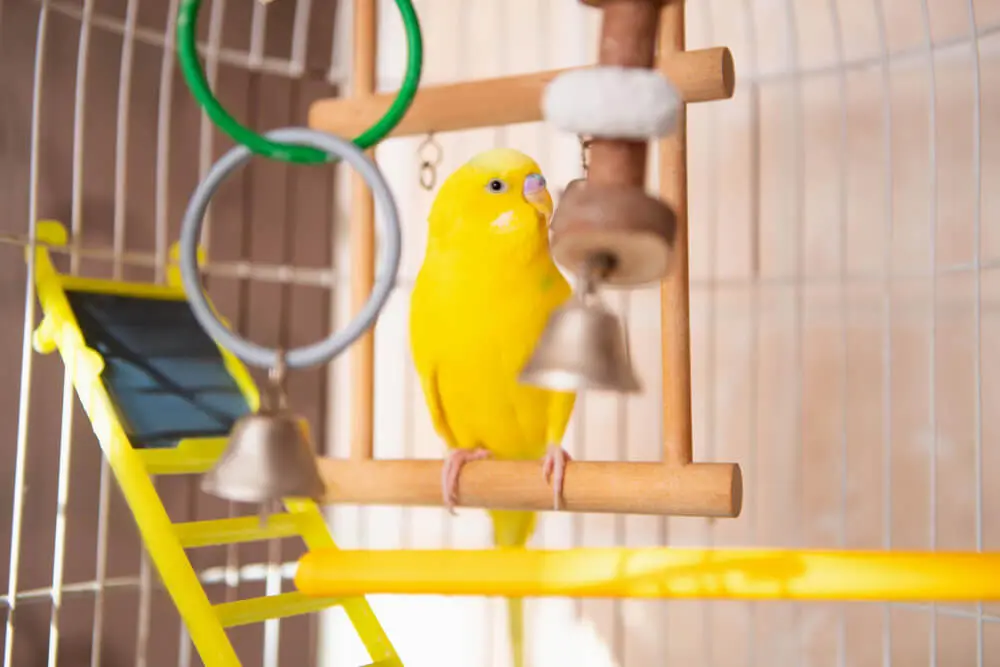
A yellow budgerigar enjoys a spacious cage equipped with various toys, illustrating an ideal environment for pet budgerigars.
General Care Tips for All Budgerigar Types
Diet: A healthy diet for all budgerigars should include a mix of high-quality seeds, pellets, and fresh fruits and vegetables. Avoid feeding them avocado, chocolate, and caffeine, as these can be toxic.
Environment: Budgerigars need a spacious cage with enough room to fly and exercise. Equip the cage with a variety of perches, swings, and toys to keep them mentally stimulated.
Social Interaction: Budgerigars are social birds that thrive on interaction. Spend time talking to and playing with your budgie daily. If you have a single budgie, consider getting a second one for companionship.
Health and Hygiene: Regularly clean the cage and replace the bedding to prevent infections. Keep an eye on your budgie’s behavior and appearance for any signs of illness. Regular vet visits are crucial to ensure they remain healthy.
Mental Stimulation: Provide your budgie with plenty of toys and change them regularly to prevent boredom. Training sessions can also be a great way to bond with your bird and provide mental exercise.
By understanding the specific characteristics and care needs of different budgerigar types, you can ensure your pet lives a happy and healthy life. Whether you have a wild-type, English, American, or Australian budgie, each bird brings its own charm and joy to your home.
Choosing the Right Budgerigar for You
Choosing the right budgerigar is an important decision that can enhance your life with a joyful and vibrant pet. With several types of budgerigars available, each with unique characteristics, it’s essential to consider your lifestyle, preferences, and the bird’s needs to find the perfect match. Here’s a guide to help you make the best choice.
Consider Your Lifestyle
Time Commitment: Budgerigars are social birds that require daily interaction and mental stimulation. If you have a busy schedule, consider whether you can dedicate enough time to play with and care for your budgie. If not, you might want to get two budgies to keep each other company.
Living Space: The size of your living space can influence which type of budgerigar is best for you. English budgerigars, being larger, need more room to fly and exercise, while American and wild-type budgies are more adaptable to smaller spaces.
Personality and Temperament
English Budgerigars: Known for their calm and relaxed demeanor, English budgerigars are great for those who prefer a more laid-back pet. They enjoy gentle interaction and can be a good fit for households with a quieter atmosphere.
American Budgerigars: These budgies are playful and curious, making them perfect for active households. Their engaging personalities make them excellent companions for families and individuals who enjoy spending time interacting with their pets.
Wild-Type Budgerigars: If you appreciate a bird that displays natural behaviors and has a lively spirit, the wild-type budgerigar might be for you. They are agile and active, requiring plenty of mental and physical stimulation.
Color Preferences
Budgerigars come in a wide array of colors and patterns. Whether you prefer the classic green and yellow of the wild-type, the serene blues of the blue series, or the unique patterns of pied and spangle budgies, there’s a budgie to match your aesthetic preferences.
Health and Care Requirements
Diet and Nutrition: All budgerigars need a balanced diet of seeds, pellets, fruits, and vegetables. However, some types, like the English budgerigar, may require more specialized care and diet to maintain their larger size and fluffier feathers.
Exercise and Enrichment: Consider the level of activity your budgerigar will need. Wild-type and American budgerigars are particularly active and will benefit from a variety of toys and ample space to fly. Ensuring your pet has enough mental stimulation is key to their well-being.
Where to Get Your Budgerigar
Reputable Breeders: Buying from a reputable breeder ensures you get a healthy bird with a known background. Breeders can also provide valuable advice on care and feeding.
Pet Stores: Many pet stores offer budgerigars, but it’s important to check the conditions in which the birds are kept. Ensure the store maintains clean and healthy environments for their animals.
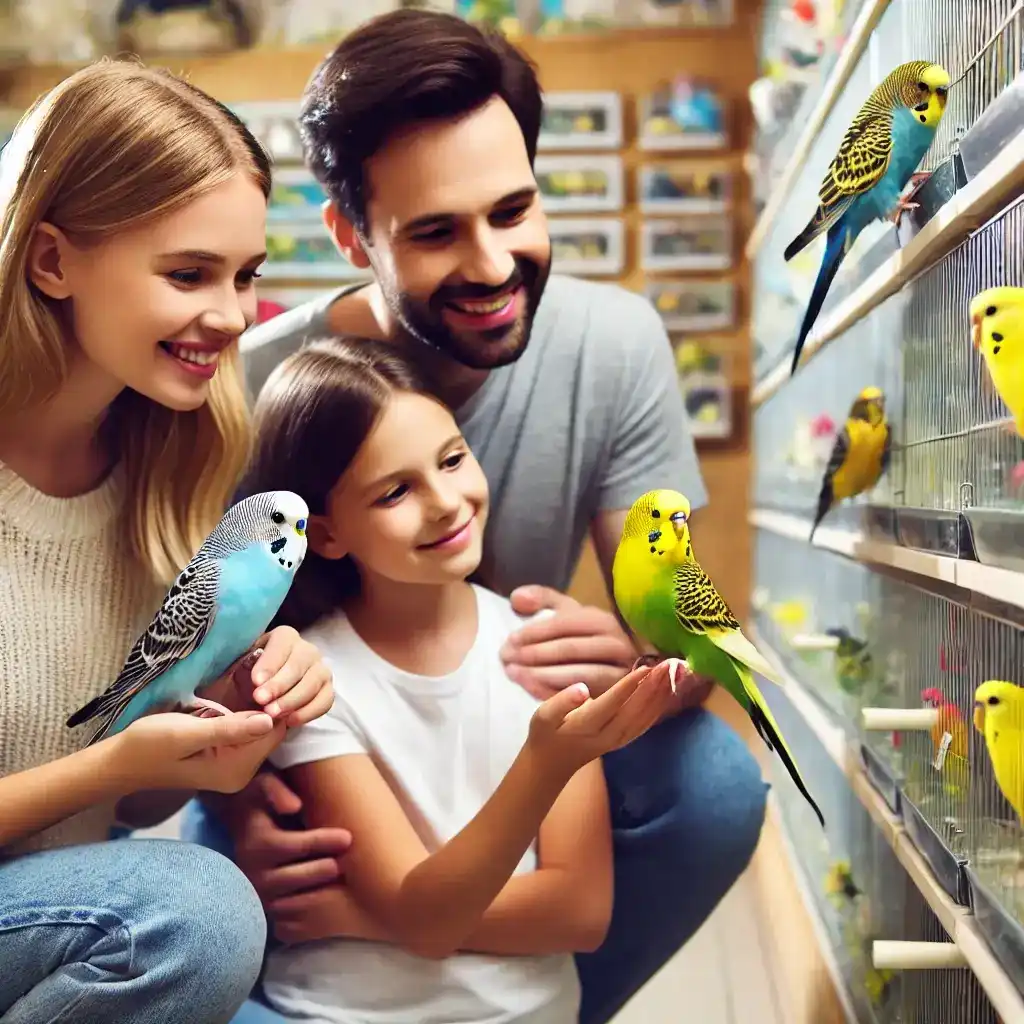
A family enjoys the experience of selecting a new budgerigar at a pet store, reflecting the joy of adopting a colorful pet.
Rescue Organizations: Adopting a budgerigar from a rescue organization is a wonderful option. Many birds in rescues are looking for loving homes, and adopting can be a rewarding experience.
Choosing the right budgerigar involves considering your lifestyle, space, and personal preferences. Whether you’re drawn to the larger and calmer English budgerigar, the playful and colorful American budgerigar, or the lively and natural wild-type budgerigar, each type has its own charm. Take your time to research and choose a bird that will thrive in your home, ensuring a happy and fulfilling companionship.
Frequently Asked Questions (FAQs)
Choosing and caring for budgerigars can raise many questions, especially for first-time bird owners. Here are some frequently asked questions to help you better understand and care for your budgerigar.
What are the different types of budgerigars?
Budgerigars, also known as budgies, come in several types, including wild-type budgerigars, English budgerigars, American budgerigars, and Australian budgerigars. Each type has unique characteristics, sizes, and temperaments, making them suitable for different owners’ preferences.
How do I choose the right type of budgerigar for me?
Choosing the right budgerigar depends on your lifestyle, space, and preferences. If you prefer a calm and larger bird, an English budgerigar might be best. For a playful and curious companion, consider an American budgerigar. Those who appreciate natural behavior may prefer a wild-type budgie. Evaluate your living conditions and personal interests to make the best choice.
What should I feed my budgerigar?
Budgerigars need a balanced diet that includes high-quality seeds, pellets, fresh fruits, and vegetables. Avoid feeding them avocado, chocolate, and caffeine, as these are toxic to budgies. Fresh water should always be available.
How much space does a budgerigar need?
Budgerigars need a spacious cage to fly and exercise. The cage should be at least 18x18x18 inches for a single budgie, with horizontal bars for climbing. Larger cages are recommended for English budgerigars and households with multiple birds.
How do I keep my budgerigar entertained?
Budgerigars are intelligent and active birds that need mental and physical stimulation. Provide a variety of toys, perches, and swings in their cage. Rotate toys regularly to prevent boredom. Interactive playtime and training sessions can also keep your budgie engaged and happy.
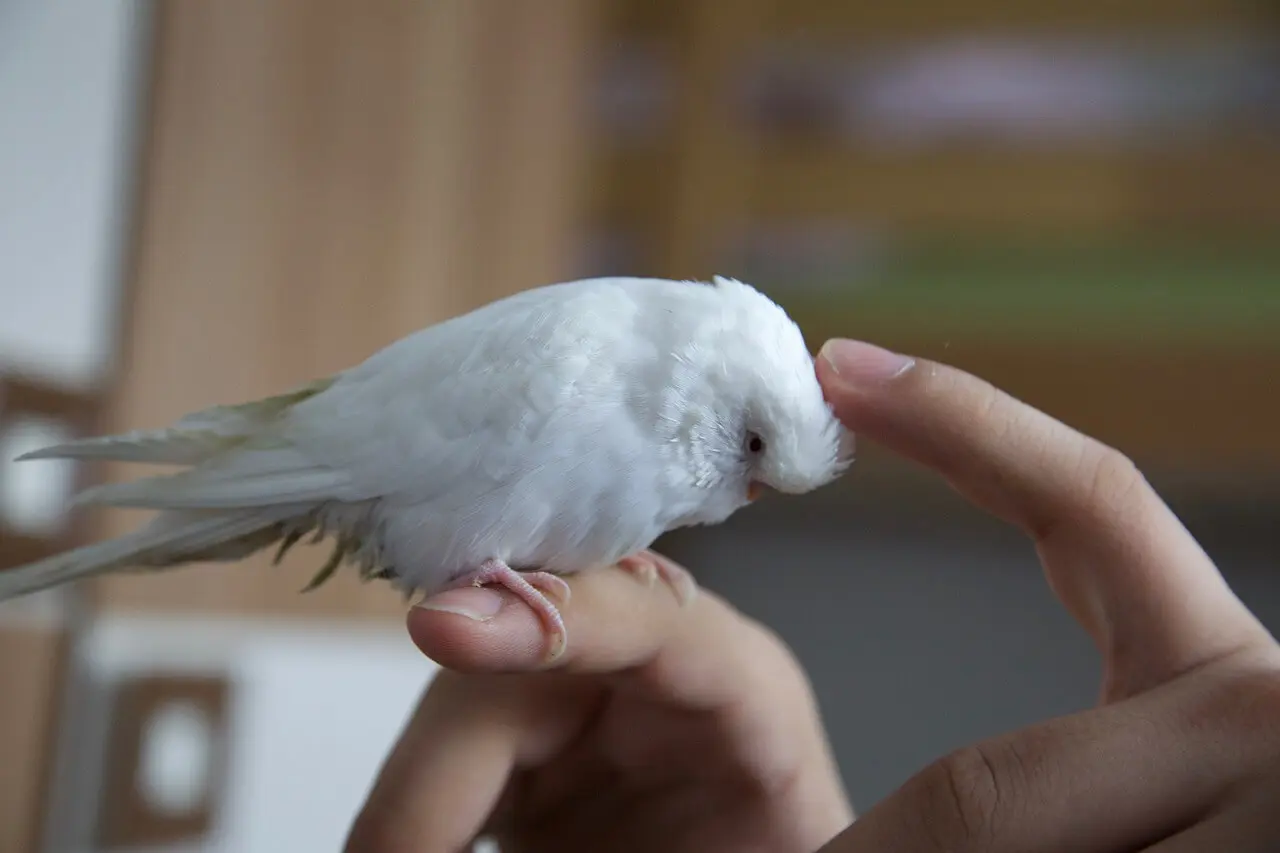
A white budgerigar gently interacts with its owner, showcasing the affectionate and tame nature of pet budgerigars.
Can budgerigars talk?
Yes, budgerigars are capable of mimicking human speech and other sounds. With patience and consistent training, many budgies can learn to say words and short phrases. Males are generally better at talking than females.
How often should I clean my budgerigar’s cage?
You should clean your budgerigar’s cage at least once a week. Replace the bedding, clean the perches and toys, and wash the food and water dishes daily. Regular cleaning helps prevent infections and keeps your bird healthy.
What are common health issues in budgerigars?
Common health issues in budgerigars include respiratory infections, mites, and nutritional deficiencies. Signs of illness include lethargy, changes in appetite, feather loss, and abnormal droppings. Regular vet check-ups are important to ensure your budgie stays healthy.
Can I keep more than one budgerigar?
Yes, budgerigars are social birds that enjoy the company of their own kind. Keeping two or more budgies can prevent loneliness and provide social interaction. However, make sure to provide a larger cage and enough resources to accommodate multiple birds.
How long do budgerigars live?
With proper care, budgerigars can live for 5 to 10 years, and some even longer. A healthy diet, regular exercise, mental stimulation, and routine vet visits can help ensure your budgie lives a long and happy life.
Understanding the common questions about budgerigars can help you provide the best care for your feathered friend. Whether you’re a new budgie owner or looking to expand your knowledge, these FAQs cover the essentials to keep your budgerigar healthy and happy.
Conclusion
Budgerigars, with their vibrant colors and charming personalities, make wonderful pets for bird enthusiasts of all levels. Understanding the different types of budgerigars, from the wild-type and English budgerigars to the playful American varieties, can help you choose the perfect companion. Each type has unique characteristics that cater to different preferences and lifestyles.
Selecting the right budgie involves considering your living space, the time you can dedicate to your pet, and the specific traits you desire. Whether you’re drawn to the classic green wild-type, the showy English budgerigar, or the lively American budgie, there’s a budgerigar to match every personality and household.
Caring for your budgerigar means providing a balanced diet, ample space to fly and play, and plenty of mental stimulation through toys and interaction. Regular vet visits and a clean environment are essential to keep your feathered friend healthy and happy.

A green budgerigar enjoys its clean and well-maintained cage, emphasizing the importance of proper care for pet birds.
By understanding the origin, history, and diverse types of budgerigars, you can appreciate these delightful birds even more. Their ability to mimic sounds, their social nature, and their beautiful color variations make budgerigars a joy to have as pets.
Whether you’re a seasoned bird owner or new to the world of budgerigars, this guide provides valuable insights to help you enjoy a fulfilling relationship with your pet. Embrace the joy of having a budgerigar and create a loving and enriching environment for your new feathered friend.

